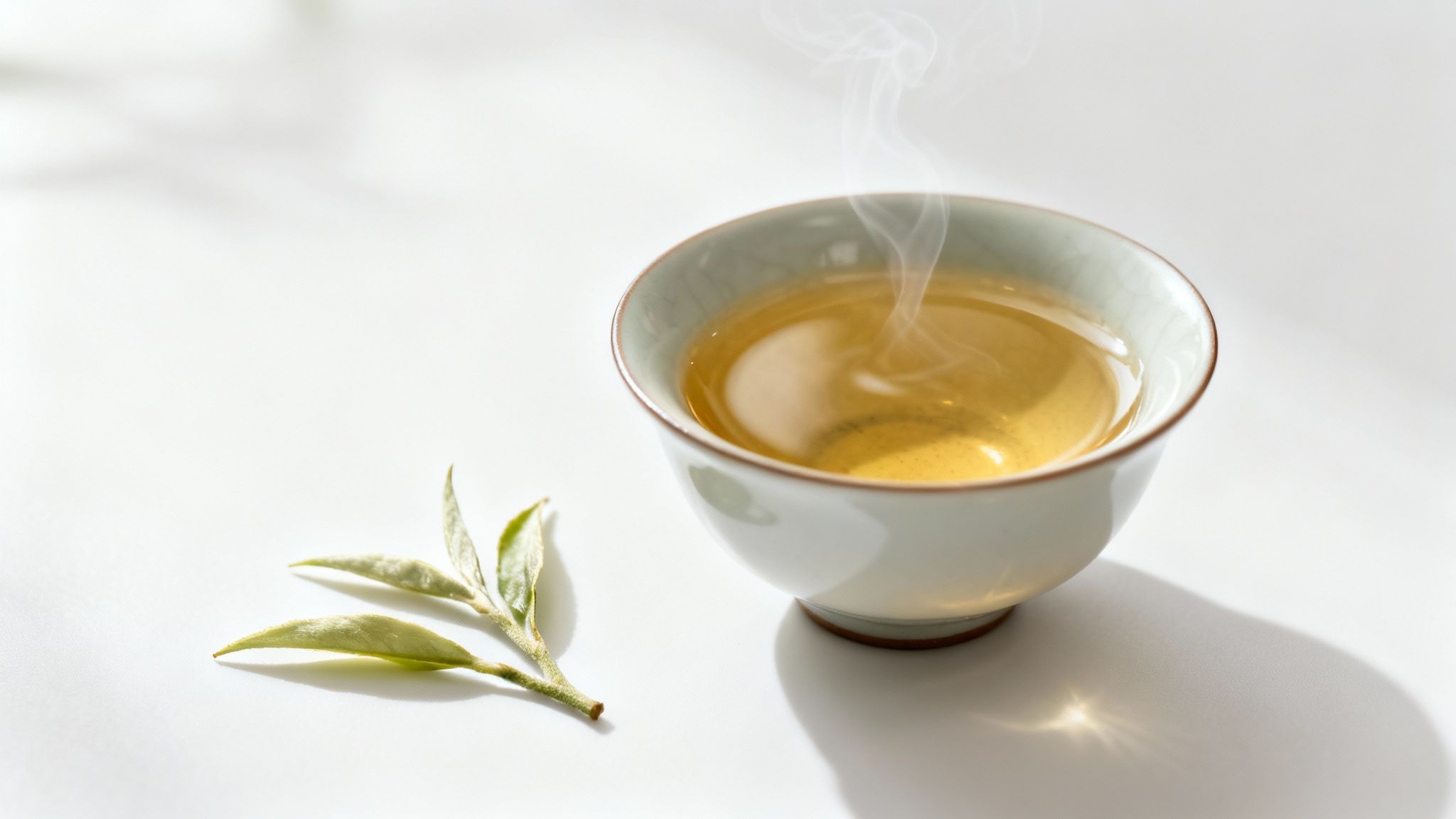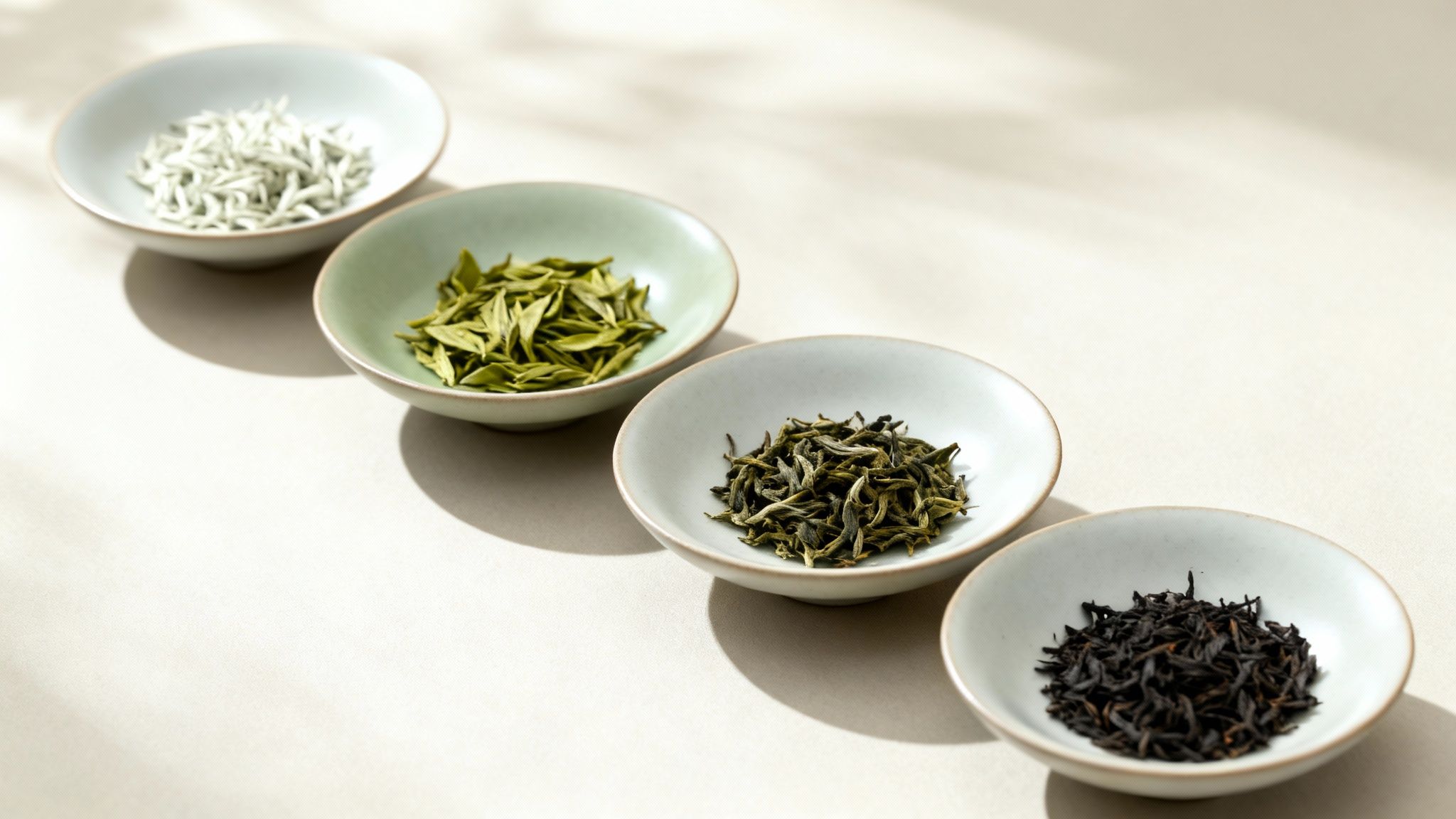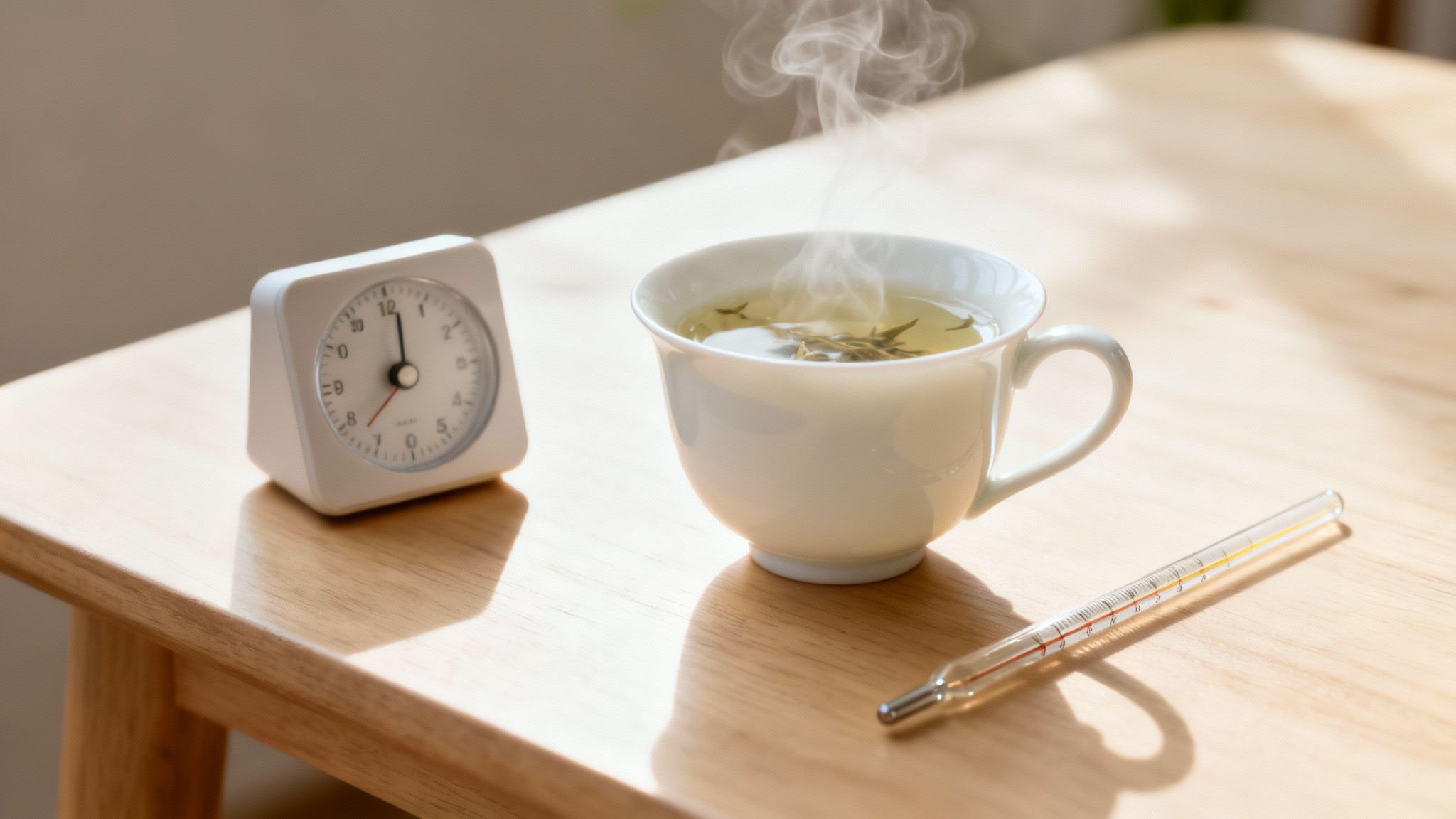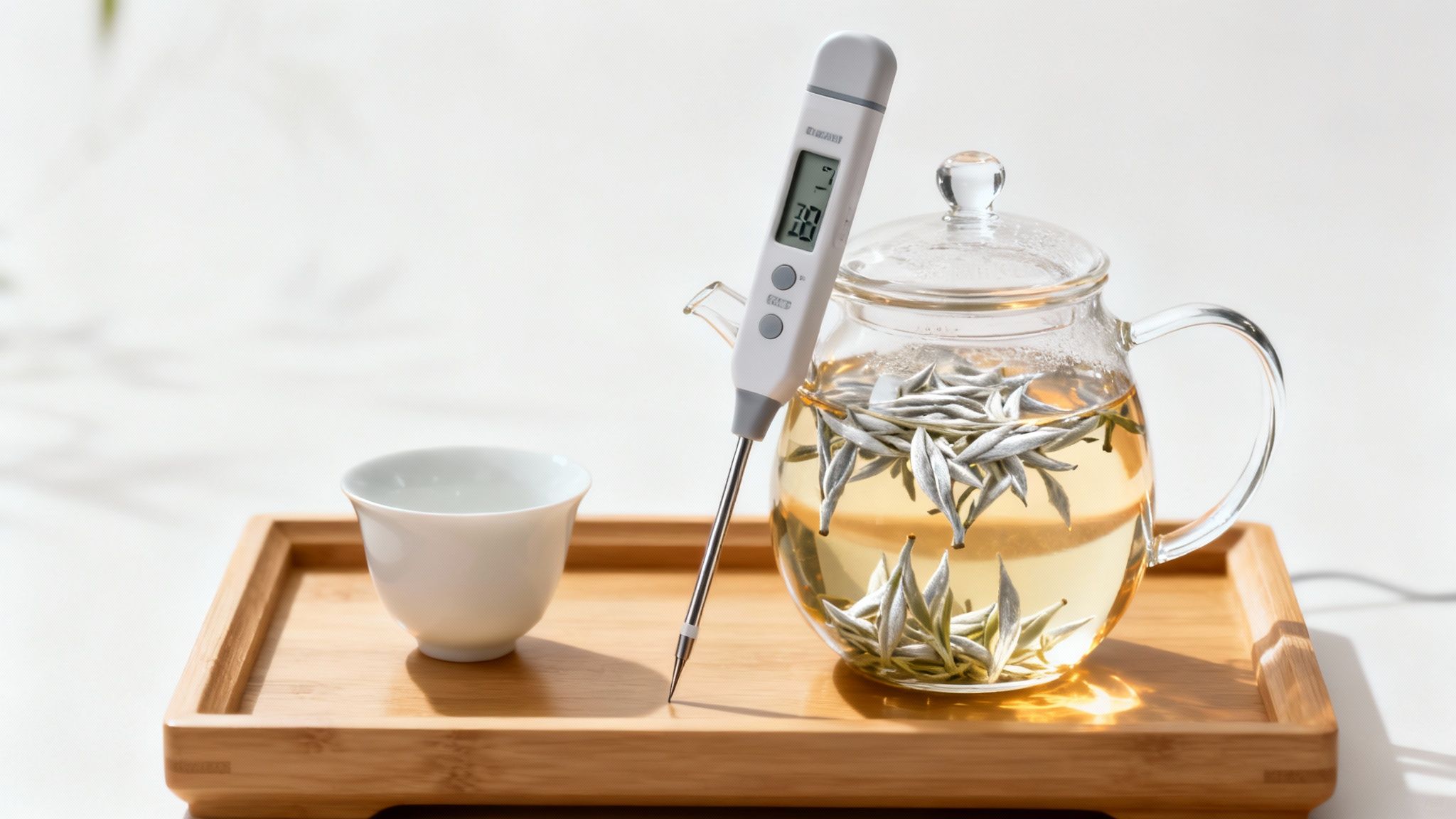So, does white tea have caffeine? The short answer is yes, but it’s a world away from the aggressive jolt of coffee or even a strong black tea. It's more of a gentle nudge, a quiet lift to your day.
Your Gentle Introduction to White Tea

If you're just starting to explore the world of white tea, you’re in good company. More and more tea drinkers across the UK are falling for its delicate, soothing qualities. So, what’s the secret? It all comes down to its beautiful simplicity.
White tea is the least processed of all true teas. It’s crafted from the youngest, most tender buds and new leaves of the Camellia sinensis plant. These are simply picked, withered, and dried. That’s it.
This hands-off approach is key. It not only protects the tea’s subtle, nuanced flavour—often described as sweet, floral, and incredibly light—but also preserves its unique natural chemistry. What you get in your cup is the purest expression of the tea plant.
Why Is White Tea Gaining Popularity?
It’s not just about the flavour, though. Many people are turning to white tea as a more mindful alternative to stronger caffeinated drinks. It offers a calm, focused alertness that’s perfect for a quiet afternoon read or a gentle start to the morning.
And it’s not just a niche interest; the numbers back it up.
The UK white tea market was valued at around USD 80 million back in 2017 and is expected to climb to USD 113.6 million by 2025. This growth is being fuelled by a real consumer shift towards wellness drinks and the unique appeal of both organic and conventional white teas.
This surge shows a clear demand for a gentler, more refined caffeine source. It seems more of us are discovering what makes this brew so special. You can dig deeper into these trends in the UK white tea market report on Grand View Research.
In this guide, we'll walk you through everything you need to know to get the most out of this elegant brew.
Where White Tea Fits in the Tea Family

To really get a feel for white tea, it helps to know where it sits in the grand scheme of things. You might be surprised to learn that all the "true" teas—that's white, green, oolong, and black—all come from the very same plant: Camellia sinensis. The incredible differences in flavour, colour, and even caffeine don't come from different plants, but from what happens to the leaves after they've been picked.
The secret lies in a process called oxidation. It’s the same natural reaction you see when you cut an apple and leave it out on the side; the flesh slowly turns brown as it's exposed to the air. Tea leaves do the exact same thing, and how much oxidation is allowed to happen is what defines the type of tea it will become.
This is where white tea really shines. It's the least processed of all its relatives, making it the most delicate and the closest you can get to the tea leaf in its natural state.
The Gentle Art of Simplicity
Unlike its cousins, which might be rolled, shaped, or fired, white tea’s journey from leaf to cup is beautifully simple. First, the fresh buds and young leaves are left to wither, which gently reduces their moisture. Then, they are carefully dried. That’s it.
By skipping any steps that would encourage heavy oxidation, the leaves keep their delicate, silvery-white appearance and a whole host of their natural compounds. This minimalist approach is exactly what creates its unique, subtle character and influences its caffeine content.
By keeping the processing gentle and natural, white tea holds onto a different balance of compounds compared to its more oxidised cousins like black tea. This delicate nature is what gives it a smoother, more nuanced energy lift.
This commitment to purity is what creates a tea so many of us in the UK have come to admire. Our love for tea is, of course, legendary—we get through about 36 billion cups annually. While a strong black tea has long been the nation's go-to, speciality brews like white tea are finding a devoted following, particularly among those keen to explore new flavours.
A Quick Comparison of Tea Processing
So, how does this minimalist craft compare to other teas from the same plant? Let's break it down.
- White Tea: Unoxidised. The leaves are simply withered and dried. Pure and simple.
- Green Tea: Also unoxidised. Here, the leaves are quickly heated (either steamed or pan-fired) to stop any oxidation before they're rolled and dried.
- Oolong Tea: Partially oxidised. These leaves are bruised and allowed to oxidise anywhere from 10% to 80% before the process is halted with heat.
- Black Tea: Fully oxidised. The leaves are rolled to break them down and then left to fully oxidise, which creates those deep, dark colours and robust flavours we know and love.
Understanding these differences is the key to appreciating why white tea offers such a unique experience. If you’re curious to learn more, you can dive deeper into the different types of tea in our detailed guide.
How Much Caffeine Is in Your Cup?

There’s a common myth that white tea sits at the very bottom of the caffeine ladder, always containing less than its green or black tea cousins. While there's some truth to it, the reality is far more nuanced and, frankly, much more interesting. The amount of caffeine in your cup isn't a fixed number; it's a dynamic result of the plant, the leaf, and—most importantly—how you brew it.
Think of it this way: the tea leaves hold a certain potential for caffeine, but you're the one who decides how much of it ends up in your cup. A few key factors come into play, and understanding them gives you complete control over your brew’s gentle energy boost. In fact, a strongly brewed white tea can easily pack more of a punch than a lightly steeped black tea.
This means you can tailor your cup of white tea to be exactly what you need, whether that's a subtle morning lift or a very mild afternoon soother.
What Shapes the Caffeine Content?
The caffeine story starts long before the leaves reach your teapot. The specific variety of the Camellia sinensis plant, when it's harvested, and even which part of the plant is picked all play a role. For instance, the tender young buds and leaves—the very ones prized for top-tier white teas like Silver Needle—actually contain higher concentrations of caffeine. It’s the plant's natural defence mechanism to ward off insects.
But the biggest influence on the caffeine level in your final cup comes down to your brewing technique.
- Water Temperature: Hotter water is far more efficient at extracting caffeine. Using water just off the boil (around 100°C) will pull out a lot more caffeine than the gentler temperatures (75-85°C) we'd recommend for protecting white tea’s delicate flavour.
- Steeping Time: The longer the leaves swim, the more caffeine they release. A quick one-minute steep will give you a very low-caffeine brew, whereas letting it infuse for five minutes could extract around 70% of the leaf’s total caffeine.
- Leaf Quantity: It might sound obvious, but using more tea leaves will naturally result in a more caffeinated drink. It’s easy to get carried away when spooning out beautiful, fluffy loose-leaf tea, so measuring is key if you're watching your intake.
You Are in Control of the Caffeine
This is where the power shifts entirely to you. By tweaking these simple variables, you become the master of your teacup. Want a richer, more stimulating brew? Use slightly hotter water and let it steep for another minute or two. Prefer something incredibly light with just a whisper of caffeine? Go for cooler water and a much shorter infusion time.
The biggest myth is that tea types have fixed caffeine levels. The truth is, how you brew has more impact than the colour of the tea. You can customise the caffeine in your white tea with every single cup you make.
This hands-on approach means you can enjoy white tea at any time of day, perfectly suited to your mood and energy needs. It’s not just about drinking tea; it’s about creating an experience that’s tailored specifically for you. That gentle, nuanced energy of white tea is right at your fingertips.
Caffeine Showdown: Tea vs. Coffee
To put it all into perspective, it helps to see how white tea stacks up against other familiar drinks. While brewing methods cause a lot of variation, we can still get a good general idea.
| Beverage (250ml) | Typical Caffeine Range (mg) | Notes |
|---|---|---|
| White Tea | 6 - 75mg | Hugely dependent on bud vs. leaf and brewing style. Can be very low or surprisingly high. |
| Green Tea | 15 - 70mg | Similar to white tea, with Matcha being a notable high-caffeine exception. |
| Black Tea | 40 - 120mg | Generally higher due to oxidation and typically brewed with hotter water for longer. |
| Coffee (Brewed) | 95 - 200mg | The undisputed heavyweight, with a much higher caffeine concentration. |
As you can see, while coffee is in a league of its own, the lines between the different teas are much blurrier. Your brewing choices are what truly define the final caffeine content in your cup.
Discovering the Health Benefits of White Tea
While it's the delicate flavour and gentle lift that first draws people to white tea, it's the impressive health benefits that often turn them into devoted fans. This isn't just old-world wisdom; modern science shows that white tea is brimming with compounds that can be a brilliant addition to a healthy lifestyle.
So, what's its secret? It all comes down to how little it's processed. Because the leaves are simply withered and dried, white tea holds onto an exceptionally high concentration of antioxidants, especially a group known as polyphenols and catechins.
You can think of antioxidants as your body's personal clean-up crew. They get to work neutralising unstable molecules called free radicals, which can cause damage to our cells over time – a process called oxidative stress. By helping to combat this stress, the antioxidants in white tea are a fantastic way to support your wellbeing from the inside out.
Supporting a Healthy Heart
One of the most exciting areas of research into tea catechins is their link to cardiovascular health. It turns out these potent compounds can contribute to a healthy heart in a few different ways.
Studies suggest that the antioxidants in white tea may help our blood vessels stay relaxed and flexible. They might also play a role in managing cholesterol levels. Making white tea a regular part of a balanced diet is a simple, enjoyable way to show your heart a bit of love.
When you make white tea part of your daily ritual, you're getting a high level of catechins linked to numerous positive health outcomes. It's an easy swap that can support your long-term wellness.
Nurturing Radiant Skin
It’s not just our insides that benefit. Those same antioxidants can work wonders for our skin, too. Oxidative stress, which can be accelerated by things like UV rays and pollution, is a key factor in skin ageing.
The compounds found in white tea may help protect the skin’s natural collagen and elastin — the very things that keep it looking firm and youthful. Of course, it's no replacement for your sunscreen, but a daily cup can be a lovely addition to your skincare routine, helping to promote a healthy, glowing complexion.
A Gentle Partner in Weight Management
Lastly, white tea can be a helpful companion on a weight management journey. The combination of its natural caffeine and catechins, particularly one called Epigallocatechin gallate (EGCG), has been studied for its potential to give your metabolism a gentle nudge.
This natural duo may encourage the body to burn fat a little more efficiently. Paired with a sensible diet and regular exercise, white tea offers a subtle, supportive boost. It’s certainly not a magic bullet, but it's another tool in the box to help you reach your wellness goals in a balanced, enjoyable way.
How to Brew the Perfect Cup

Brewing white tea is a bit of a gentle art, but it's one that’s surprisingly easy to get the hang of. Getting it right is the secret to unlocking its famously delicate flavour and, crucially, managing the amount of caffeine that ends up in your cup.
Unlike a robust black tea that can take boiling water head-on, white tea’s delicate leaves need a much softer touch. Go in too hot, and you’ll scald them, leaving you with a bitter, astringent brew.
Think of it like giving the leaves a warm bath rather than a scalding shower. This gentle approach coaxes out all those sweet, floral notes without any of the harshness.
The Ideal Water Temperature
For that perfect cup, you’re aiming for a water temperature between 75°C and 85°C.
No fancy temperature-controlled kettle? No problem. Simply boil the water, then let it sit for a minute or two to cool down before pouring. That small pause makes all the difference, protecting the tea's fragile character and giving you a beautifully smooth, balanced brew.
Steeping for Success
Once your water is just right, it’s time to steep. White tea doesn't need long, so keep an eye on it.
Here’s a simple guide to get you started:
- Measure Your Leaves: Use about two teaspoons (roughly 2-3 grams) of loose-leaf white tea for every 250ml of water. The leaves are quite light and fluffy, so it might look like more than it is.
- Warm Your Teapot: A simple but effective trick. Pour a splash of the hot water into your teapot or mug, swirl it around, then tip it out. This stops the water temperature from dropping too quickly when you start to brew.
- Pour and Steep: Pour your 75-85°C water over the tea leaves and let them infuse for 1-3 minutes. A shorter steep gives a lighter flavour with less caffeine, while a longer one will produce a stronger brew.
- Strain and Serve: Once steeped, strain the leaves and enjoy your tea straight away. Good quality white teas can often be re-steeped, with each cup revealing new layers of flavour.
The perfect brew is a delicate balance of time and temperature. A short, gentle steep with cooler water is the secret to a cup that’s both flavourful and subtly energising, putting you in control of the white tea with caffeine experience.
Mastering these simple steps will transform your tea-making. For a deeper dive into the craft, our guide on how to brew loose leaf tea has even more tips and techniques to explore.
Choosing Your Ideal White Tea
Now that you know how to brew the perfect cup, it’s time for the fun part: exploring the different types of white tea. Navigating the world of white tea is a delightful journey, and knowing what to look for will help you find a brew that’s just right for you. You'll most often come across two celebrated varieties, Silver Needle and White Peony, each with a distinct character.
Think of them as two siblings. Silver Needle is the quiet, elegant one, while White Peony is a bit more robust and expressive. Which one you prefer really just comes down to taste.
Silver Needle (Bai Hao Yin Zhen)
This is the most prized and delicate white tea you can find. It's made exclusively from the unopened, silvery-white buds of the tea plant, carefully harvested in early spring.
- Flavour Profile: Expect a remarkably subtle, sweet, and clean taste. It often has notes of honeydew melon, apricot, and a light floral sweetness, all wrapped up in a velvety smooth finish.
- Caffeine Level: Because it’s made from young buds, Silver Needle has the potential for a higher caffeine content. However, its delicate nature demands gentle brewing, which often results in a lighter, less caffeinated cup.
White Peony (Bai Mu Dan)
White Peony offers a slightly bolder experience. It includes both the young buds and the first one or two leaves from the tea shoot, which creates a more complex and fuller-bodied brew.
- Flavour Profile: The flavour is richer than Silver Needle, with a beautiful balance of floral notes and a subtle nuttiness. It brews to a lovely golden hue and has a slightly more pronounced, yet still soft, character.
- Caffeine Level: It generally contains a moderate amount of caffeine, making it a perfect all-day tea.
When you're picking out a white tea, take a good look at its appearance and give it a smell. High-quality leaves should look fresh, not dull or broken, and have a sweet, clean scent. That's your first clue to the quality inside the packet.
Ultimately, choosing between them is a matter of personal taste. If you're after supreme delicacy and sweetness, Silver Needle is your perfect match. But if you enjoy a brew with a bit more body and a complex flavour profile, White Peony will be an excellent choice.
Your White Tea Questions Answered
Even when you know the basics of white tea, a few questions always seem to pop up. We get it. Let's run through some of the most common ones so you can brew your next cup with total confidence.
A big one is whether you can enjoy a white tea before turning in for the night. While it's certainly much lighter on caffeine than coffee, it’s not completely caffeine-free. If you're particularly sensitive, you're probably better off switching to a herbal infusion a good few hours before bed. For some lovely options, have a look at our guide to non-caffeinated teas.
People also ask if going organic makes a difference to the caffeine. In short, no. "Organic" is all about the farming methods—no pesticides, that sort of thing. It doesn't actually change the natural chemistry of the tea plant itself. The caffeine kick comes down to the plant varietal and how you brew it, not the organic label.
How Does the Caffeine Feel?
So, what’s the experience like? How does the caffeine in white tea feel compared to, say, a punchy flat white? Most people describe it as a gentle, steady lift rather than the sudden jolt you get from coffee.
The secret lies with L-theanine, an amazing amino acid found in tea. It works in harmony with caffeine to create a sense of calm alertness. This is why tea can help you focus without the jittery side effects that sometimes come with a strong coffee.
This unique combination delivers a much more balanced and sustained energy boost, perfect for keeping you on track throughout the day without the dreaded afternoon crash.
Ready to dive into the delicate world of white tea? Discover our premium, ethically sourced whole leaf teas at Jeeves & Jericho and find your perfect gentle brew today.


